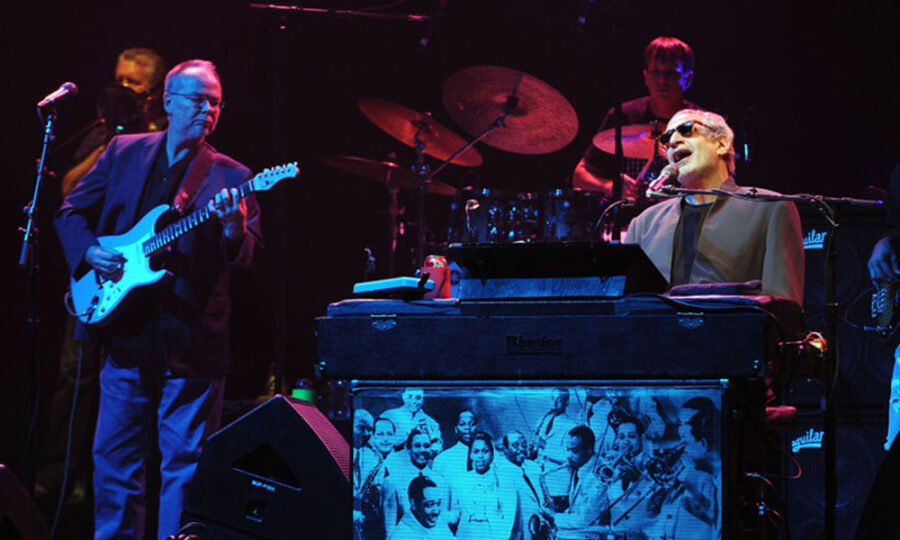Five Cool Things About Steely Dan

Walter Becker (right) and Donald Fagen pose for a portrait while making their album ‘The Royal Scam’ at The Village Recorder studio on November 23, 1975, in Los Angeles, California. Source: somuchgreatmusic.com
The studio-based duo was on a timeless quest for sonic perfection.
Prologue: The Birth of Steely Dan
In the sixties, two young fellows named Donald Fagen and Walter Becker gently collided at Bard College in Annandale-on-Hudson, New York. They shared a love of music, especially jazz. They began writing songs together.
Becker and Fagen moved to New York City in 1969 to immerse themselves in the city’s thriving music scene. They composed the soundtrack for a low-budget movie. They toured with an oldies act, Jay and the Americans. Becker and Fagen even tried to peddle their tunes in the Brill Building in midtown Manhattan.
Los Angeles
They got a break when they met music executive Gary Katz, who was about to move to Los Angeles to become a staff producer at ABC Records. Katz recognized songwriting talent and hired Becker and Fagen. They all moved west.
While under Katz’s tutelage, it became apparent that the duo’s songs were “too complex” for ABC artists. So Becker and Fagen began putting together what would become Steely Dan. They made important hires, including singer David Palmer and guitarists Jeff “Skunk” Baxter and Elliott Randall.
Many of the original band departed when Becker and Fagen opted out of touring in 1974, preferring to employ studio musicians for individual albums. Here are five cool things about Steely Dan:
1) “Reelin’ in the Years” and nods from two guitar Gods
Steely Dan’s debut album, Can’t Buy a Thrill, was released in 1972. It yielded two hits, “Do It Again” and “Reelin’ in the Years.” The song, “Dirty Work,” sung by David Palmer, got lots of radio play.
The guitar work on “Reelin’ in the Years,” performed by Elliott Randall, was a shot heard across the Atlantic Ocean that shook certain esteemed British masters of the craft. Led Zeppelin’s Jimmy Page declared Randall’s work to be his all-time favorite guitar solo. None other than Eric Clapton was so “blown away” by the song’s guitar licks that he wanted to meet the man responsible.
Here is a lip-synched version of “Reelin’ in the Years,” for the Midnight Special, published by Ruben Rock Gomez via YouTube:
2) The ‘Steely Dan’ moniker
William S. Burroughs was part of the 1950s “beat generation” of writers that included Jack Kerouac and Allen Ginsberg. His seminal work, Naked Lunch (1959), contains a lot of drug use (Burroughs was a big-time druggie) and hallucinations by the main character.
And dildos.
Naked Lunch has many explicit sex passages. During one, a character named Mary straps on a large, steam-powered dildo given the name “Steely Dan III from Yokohama.” Our duo, who greatly admired beat writers, presumably got a laugh out of it. Steely Dan stuck.
3) The Jazz thing
Although Becker and Fagen were big jazz fans, it’s plain to see why they didn’t become jazz musicians.
First, it just wasn’t in either’s DNA to write long, drawn-out, instrumental spontaneous compositions. Often, spontaneity and perfectionism are on opposite poles. The duo exulted in drawing “musical ideas from the entire American spectrum, especially jazz, and compressing them into immediately available three-minute vignettes.” That was their working method.
“We thought superimposing jazz harmonies on pop songs was subversive,” Becker told the LA Times.
Their perfectionism was probably the major cause of their decision to stop touring and remain in the studio, where precision counted.
Storytelling
Second, Becker and Fagen were “literature nerds” with their own stories to tell. Fagen majored in English literature at Bard. Both were fans of 1950s novelists (Burroughs included) and science fiction (which might account for some of their “really creepy lyrics”). Donald Fagen once said that when he sings, he becomes the “character” in the song.
So, given the lyrics-free zone that a lot of jazz occupies, it is hard to imagine them making that leap. Also, rock stars make more money.
4) Roger Nichols, the engineer behind Steely Dan
Sound engineer extraordinaire Roger Nichols won eight Grammy Awards for his work with Steely Dan. Becker and Fagen saw a kindred spirit in Nichols for his penchant to do whatever it took to achieve impeccable sound quality.
Nichols met Steely Dan in LA in 1971 when Becker and Fagen were songwriters for Gary Katz at ABC Records. During a demo recording session, Nichols was recruited out of the blue when it seemed all the other engineers scattered rather than put up with take after take until the song was “perfect.” Nichols had no problem with it.
Becker and Fagen made sure that Nichols was seated behind the recording console for every Steely Dan album thereafter. Here’s producer Gary Katz on Roger Nichols’ recording legacy:
The records we did could not have been done without Roger. He was just maniacle about making the sound of the records be what we liked…He always thought there was a better way to do it, and he would find a way to do what we needed in ways that other people hadn’t done yet.
For more information on the late Roger Nichols, visit his website.

Steely Dan on a reunion tour. Note the jazz imagery attached to Fagen’s keyboard. Photo by Denise Truscello, WireImage
5) So many good songs
There was a rock music explosion in the 1970s, and Steely Dan was on the cutting edge with their brand of “ruthless cool.”
Here are some memorable Steely Dan songs: “My Old School” and “Bodhisattva” (Countdown to Ecstacy), “Any Major Dude Will Tell You” and “Rikki Don’t Lose That Number” (Pretzel Logic), “Black Friday” (Katy Lied), “Don’t Take Me Alive” (The Royal Scam), “Peg,” “Black Cow,” and “Deacon Blues,” (Aja), “Hey Nineteen” (Gaucho), and “FM (No Static at All)” (soundtrack to the film, FM).
That’s quite a list and there are many, many more. We’ll close with a video of the autobiographical “My Old School,” published by BetaGems Lost Media via YouTube. If you listen to the lyrics, “Daddy G” is famed Watergate villain G. Gordon Liddy, Who was then a dean of Bard College.
Coda
Walter Becker
Walter Becker was not a happy camper toward the end of Steely Dan’s first run (1971-81). He had become addicted to narcotics and was hit by a taxicab while fighting a wrongful death lawsuit due to his girlfriend overdosing in his apartment.
He moved to Hawaii, kicked the dope, and became an avocado rancher. He came back a healthy man and joined Fagen for Steely Dan’s 1993 reformation, which included touring for the first time in 19 years. Walter Becker died in 2017 of esophageal cancer at the age of 67.
Donald Fagen
After Steely Dan’s breakup in 1981, Donald Fagen released a celebrated solo album, The Nightfly, which included the hit single, “I.G.Y.” The album went platinum. Fagen has released four solo albums over the years.
After Becker’s death, Fagen has been preoccupied with keeping Steely Dan’s banner flying high. He recently released two Steely Dan live albums. Fagen continues to tour as Steely Dan and had this to say to Variety:
I think people will understand that Walter’s not there and it will never be quite the same without him. And I couldn’t hope to replace him, but we still have a great band.
Steely Dan was inducted into the Rock & Roll Hall of Fame in 2001.















































































































